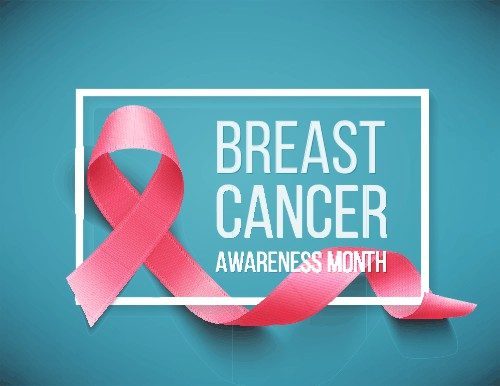September was Prostate Cancer Awareness month. Now that October has arrived, it is time to shift the focus to women, as this is National Breast Cancer Awareness month. Breast cancer does occur most often in women, but do keep in mind it can occur in men also. Except for skin cancers, breast cancer is the most common cancer in American women. There is a 12% risk of a women in the United States developing breast cancer at some point in her life. This means that 1 out of every 8 women will develop the disease. `
What is breast cancer?
Breast cancer begins when normal cells in the breast start to grow out of control. The cells typically form a tumor, which can usually be felt as a lump or viewed on an x-ray. The tumor becomes cancer if the cells begin to spread to surrounding tissues or other parts of the body. Please keep in mind that most breast lumps are not cancerous (benign), but it is important to have any lump or breast change checked by a health care professional.
What are some of the risks?
Here are some of the common risk factors further explained:
• Lack of physical activity: Studies have shown that regular physical activity reduces breast cancer risk, particularly in women past menopause. This may be due to the fact that activity helps regulate body weight, reduces inflammation, and helps to balance hormones, and increases overall energy. The American Cancer Society recommends at least 150 minutes of moderate intensity or 75 minutes of vigorous intensity activity weekly for all adults. The best benefits are found when these minutes are spread throughout the week.
• Being Overweight: Being overweight after menopause can increase the risk for breast cancer. Prior to menopause, women get most of their estrogen from their ovaries. After menopause, a women’s ovaries stop producing estrogen. It is at this time that most of a women’s estrogen comes from fat tissue. Having more fat tissue can increase estrogen levels which in turn increases risk for developing breast cancer. Being overweight also leads to an increase in blood insulin levels. Increased insulin levels have also been linked with the development of some cancers.
• Alcohol Consumption: Women who consume 2 to 3 drinks daily that contain alcohol, have a 20% higher risk of breast cancer, than those women who do not drink alcohol. For women who do drink alcohol, it is recommended to limit to no more than 1 serving daily.
• Birth Control: Many studies have concluded that women who are on oral contraceptives have a slightly increased risk for developing breast cancer. However, after stopping oral contraceptives, the risk goes back to normal after about 10 years. The birth control shot (Depo-Provera), has been linked to an increase risk of breast cancer. There appears to be no increased risk in women 5 years after stopping the shot.
• Breast implants: Certain types of breast implants are linked to a rare cancer called large cell lymphoma. It occurs more often with implants with rough surfaces rather than smooth.
• Post Menopause Hormone Therapy: Hormone therapy can be used to help relieve symptoms of menopause and to prevent osteoporosis.
There are several forms of hormone therapy used:
• Combined hormone therapy (HT): HT is used for women who still have a uterus, and includes a combination of estrogen and progesterone. Studies have shown that some forms of synthetic combined hormone therapy (HT) after menopause can increase the risk of breast cancer. However, a women’s risk of breast cancer returns to that of the general population within 5 years of stopping treatment.
• Estrogen therapy (ET): Estrogen alone can be used for women who no longer have a uterus. There does not seem to be a significant increased risk of breast cancer with the use of estrogen alone.
• Bio-identical hormone therapy: Research indicates that the use of bio-identical hormone therapy is an effective and safe method of hormone delivery in both men and women. Implants (pellets), placed painlessly under the skin, release small doses of hormones providing optimal therapy. They are released when the body needs it. Pellet implants are used to restore hormonal balance in both men and women. They are natural, safe and very effective. Pellets remain the only hormone replacement system that provides steady blood serum levels over time. There is no increased risk of breast cancer with bio-identical hormone therapy.
Click here for more information on Bio-identical Hormone Replacement Pellet therapy at Blue Sky MD.
How can I lower my risk?
There is no 100% sure way to prevent breast cancer. However, there are things women can do to help lower their overall risk.
• Know how your breasts normally look and feel.
• Perform monthly self breast exams.
• Have regular mammograms. Mammograms help detect breast cancer at an early stage.
Here are the current recommendations:
➔ Women between 40-44 should have the option to start screening yearly.
➔ Women 45-54 should have annual mammograms.
➔ Women 55 and older can start every other year, or can decide to continue yearly.



